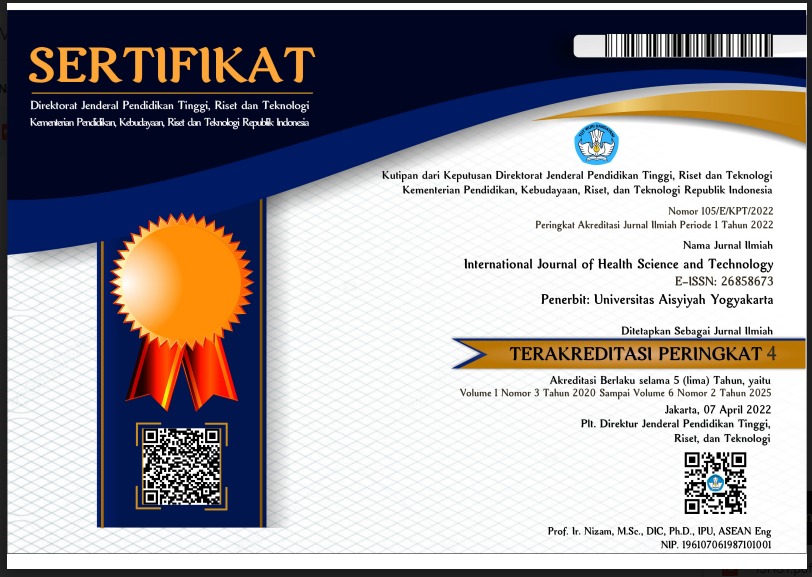Hyperemesis gravidarum in premarital pregnancy: scoping review
DOI:
https://doi.org/10.31101/ijhst.v3i3.1981Abstract views 690 times
Keywords:
hyperemesis gravidarum, premarital, pregnantAbstract
Downloads
References
Aleyasin, A., Saffarieh, E., Torkamandi, H., Hanafi, S., Sadeghi, F., Mahdavi, A., Bahmaei, F., & Javadi, M. (2016). Comparison of efficacy of granisetron and promethazine in control of hyperemesis gravidarum. Journal of Obstetrics and Gynecology of India, 66(6), 409–414. https://doi.org/10.1007/s13224-015-0709-6.
Birkeland, E., Stokke, G., Tangvik, R. J., Torkildsen, E. A., Boateng, J., Wollen, A. L., Albrechtsen, S., Flaatten, H., & Trovik, J. (2015). Norwegian PUQE (pregnancy-unique quantification of emesis and nausea) identifies patients with hyperemesis gravidarum and poor nutritional intake: A prospective cohort validation study. PLoS ONE, 10(4), 1–15. https://doi.org/10.1371/journal.pone.0119962
Bottomley, C., & Bourne, T. (2012). Management strategies for hyperemesis. Best Practice and Research: Clinical Obstetrics and Gynaecology, 23(4), 549–564. https://doi.org/10.1016/j.bpobgyn.2008.12.012
Cooper. (2019). Hyperemesis gravidarum pada ibu hamil. 5–10.
Goossens, J., Van Den Branden, Y., Van Der Sluys, L., Delbaere, I., Van Hecke, A., Verhaeghe, S., & Beeckman, D. (2016). The prevalence of unplanned pregnancy ending in birth, associated factors, and health outcomes. Human Reproduction, 31(12), 2821–2833. https://doi.org/10.1093/humrep/dew266
Havnen, G. C., Truong, M. B. T., Do, M. L. H., Heitmann, K., Holst, L., & Nordeng, H. (2019). Women’s perspectives on the management and consequences of hyperemesis gravidarum–a descriptive interview study. Scandinavian Journal of Primary Health Care, 37(1), 30–40. https://doi.org/10.1080/02813432.2019.1569424
James, W. H. (2012). The sex ratio of pregnancies complicated by hospitalisation for hyperemesis gravidarum [3]. BJOG: An International Journal of Obstetrics and Gynaecology, 111(6), 636. https://doi.org/10.1111/j.1471-0528.2004.00145.x
Kloter, E., Gerstenberg, G., Berenyi, T., Gollmer, B., Flüger, C., Klein, U., Eberhard, J., Kuck, A., & Wolf, U. (2019). Treatment of hyperemesis gravidarum with anthroposophic complex therapy in 3 case reports. Complementary Therapies in Medicine, 44, 14–17. https://doi.org/10.1016/j.ctim.2019.02.011
Koudijs, H. M., Savitri, A. I., Browne, J. L., Amelia, D., Baharuddin, M., Grobbee, D. E., & Uiterwaal, C. S. P. M. (2016). Hyperemesis gravidarum and placental dysfunction disorders. BMC Pregnancy and Childbirth, 1–9. https://doi.org/10.1186/s12884-016-1174-7
London, V., Grube, S., Sherer, D. M., & Abulafia, O. (2017). Hyperemesis gravidarum: A review of recent literature. Pharmacology, 100(3–4), 161–171. https://doi.org/10.1159/000477853
Mekonnen, A. G., Amogne, F. K., & Worku Kassahun, C. (2018). Risk factors of hyperemesis gravidarum among pregnant women in Bale Zone Hospitals, Southeast Ethiopia: unmatched case-control study. Clinics in Mother and Child Health, 15(3). https://doi.org/10.4172/2090-7214.1000300
Romero-Gutierrez, G., Cruz-Arvizu, V. H., Regalado-Cedillo, C. A., & Ponce-Ponce de Leon, A. L. (2012). Prevalence of violence against pregnant women and associated maternal and neonatal complications in Leon, Mexico. Midwifery, 27(5), 750–753. https://doi.org/10.1016/j.midw.2010.06.015
Rudiyanti, R. (2019). Hubungan usia, paritas, pekerjaan dan stress dengan emesis gravidarum di Kota Bandar Lampung. 15(1), 7–18.
Tan, P. C., Vani, S., Lim, B. K., & Omar, S. Z. (2012). Anxiety and depression in hyperemesis gravidarum: prevalence, risk factors and correlation with clinical severity. European Journal of Obstetrics and Gynecology and Reproductive Biology, 149(2), 153–158. https://doi.org/10.1016/j.ejogrb.2009.12.031
Temming, L., Franco, A., Istwan, N., Rhea, D., Desch, C., Stanziano, G., & Joy, S. (2014). Adverse pregnancy outcomes in women with nausea and vomiting of pregnancy. Journal of Maternal-Fetal and Neonatal Medicine, 27(1), 84–88. https://doi.org/10.3109/14767058.2013.806473
Downloads
Published
How to Cite
Issue
Section
License
International Journal of Health Science and Technology allows readers to read, download, copy, distribute, print, search, or link to its articles' full texts and allows readers to use them for any other lawful purpose. The journal allows the author(s) to hold the copyright without restrictions. Finally, the journal allows the author(s) to retain publishing rights without restrictions
- Authors are allowed to archive their submitted article in an open access repository
- Authors are allowed to archive the final published article in an open access repository with an acknowledgment of its initial publication in this journal

This work is licensed under a Creative Commons Attribution-ShareAlike 4.0 Generic License.













